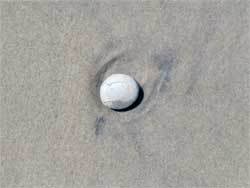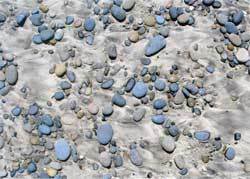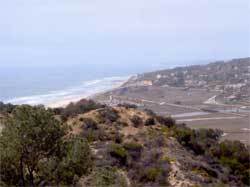Photos and footnotes on fossil shells in the West Coast Monterey Shale, San Onofre, Torrey Pines State Beach.
Geology at Torrey Pines and San Onofre
Contributed by Dave E. Matson, Oak Hill Free Press
Featured below are a few of the fossil shells that I came across earlier this year.
About 45 to 50 million years ago the West Coast resembled the East Coast in that there were barrier islands with quiet, mud-filled lagoons. The climate was such that large beds of oysters flourished along with other creatures, such as small, coiled sea snails. Eons later, that mud later got converted into somewhat greenish-gray shale--the Del Mar Formation.
The first shell photo shows a nice, whole oyster fossil resting on the Del Mar Formation. The second shell photo shows the underside of an oyster fossil along with some embedded, coiled snail shells. The 4th shell photo is a closer view of another coiled snail shell. These three fossil photos were taken at the Torrey Pines State Beach, just north of San Diego.

Enlarge Image, 96 k - san_onofre_large.jpg
Photo Courtesy Dave E. Matson
The 3rd photo is from San Onofre Beach, a short walk south of the nuclear reactors. These fossils are "only" about 20 million year old and are found in the Monterey shale.

Enlarge Image, 112 k - torrey_pines_large.jpg
Photo Courtesy Dave E. Matson
Geology Photo #1: Torrey Pines. At the very top, not much in evidence here, is the Bay Point Formation (~120,000 years) which consists of loosely consolidated, brown sediments washed down from the hills. The thick, sculpted strata is the Torrey Pines sandstone (~45 million years). It is probably the remains of sand from off shore, barrier islands. The Del Mar Formation (45-50 million years) which consists of layers of mudstone, shale and white/gray sandstone lying on a greenish shale, came from lagoonal muds occasionally flooded with sand from the barrier islands. The scene is similar to the coast of Texas today, which is flat and has barrier islands and lagoons.
Geology Photo #2: San Onofre. A secondary fault may be seen as a thin diagonal in the San Mateo sandstone (4-5 million years) truncated by a later layer of marine boulders of about 125,000 years of age. The brown strata on top is less than 120,000 years old, being washed down from the hills. The white, San Mateo sandstone is underlain by Monterey shale (15-20 million years). To the right, (out of sight) of the secondary fault is the main fault, the Christianitos Fault, which has been inactive for at least 125,000 years as indicated by the undisturbed layer of marine boulders above it.

Enlarge Image, 78 k - fossil_shells_01.jpg
Shell Photos #1 - Whole oyster fossil resting on the Del Mar Formation.
Photo Courtesy Dave E. Matson

Enlarge Image, 73 k - fossil_shells_02.jpg
Shell Photo #2 - Underside of an oyster fossil along with some embedded, coiled snail shells
Photo Courtesy Dave E. Matson

Enlarge Image, 76 k - fossil_shells_03.jpg
Photo Courtesy Dave E. Matson

Enlarge Image, 88 k - fossil_shells_04.jpg
Photo Courtesy Dave E. Matson
Del Mar Formation
Del Mar Formation
Contributed by Dave E. Matson
August 8, 2006
I'm including 7 new photos from my March 25, 2006 stop at Torrey Pines. Torrey Pines State Beach is just north of La Jolla, which is the northern coastal extreme of San Diego. The famous cove there is where I went snorkeling for years.
The following photo shows a minor unconformity, where angled strata meet level strata. The angled strata is the slow fill-in of our scour channel. Some of the layers lasted long enough to have developed their own community of shelled creatures. Later, the top of the angled strata was leveled by erosion, probably during a temporary retreat of the sea. The more strata was deposited.
|
|
These fossils in a pebble from the Del Mar Formation at Torrey Pines, California, are 45-50 million years old. I thought the pebble was kind of artsy.
|
|
Bean clams on the beach make up the lower-right photo on this page. In San Diego, years ago, I saw a dense patch of them, each clamping on to a bit of seaweed. It looked like that patch of beach was growing something!
|
|
Here, we see the green shale portion of the Del Mar Formation (45-50 million years), which was once the mud of a lagoon between a low shoreline and offshore barrier islands of sand.
|
|
Artsy pebble on sand.
|
|
|
|
Just south of the scour-channel strata are these spectacularly-colored strata. A dense layer of fossil shells is found in the strata at about the ankle level of the two visitors.
|
|
At the Torrey Pines Nature Center overlooking Soledad Valley, which is the northern boundary of the Torrey Pines area.
Barnacles and Bay Mussels on Flat Rock at Flat Rock Point. Torrey Pines State Beach, California. The beach is part of the Torrey Pines State Reserve, a Pines State Beach, California. The beach is part of the Torrey Pines State Reserve, a wildlife preserve. There, the rare, stately Torrey pines grow naturally. Their needles are gray-green and in bundles of five.
|
|
Lemonade Berry, a hearty bush, is usually found near the coastal areas. (Rhus integrifolia of the family Anacardiaceae). The fruit exudes a sticky, sour substance that can make a lemonade-like drink!
|
|
On the side of Flat Rock at Flat Rock Point, Torrey Pines State Beach, sea anemones (or some other soft creatures on the side of this rock) collect shells for protection.
|
|
At the Torrey Pines Nature Center, overlooking Soledad Valley, which is the northern boundary of the Torrey Pines area.
|
|













No comments:
Post a Comment